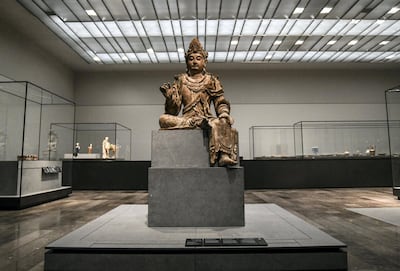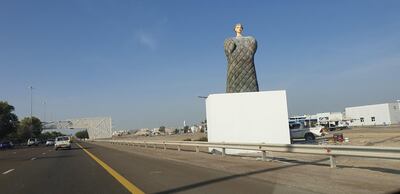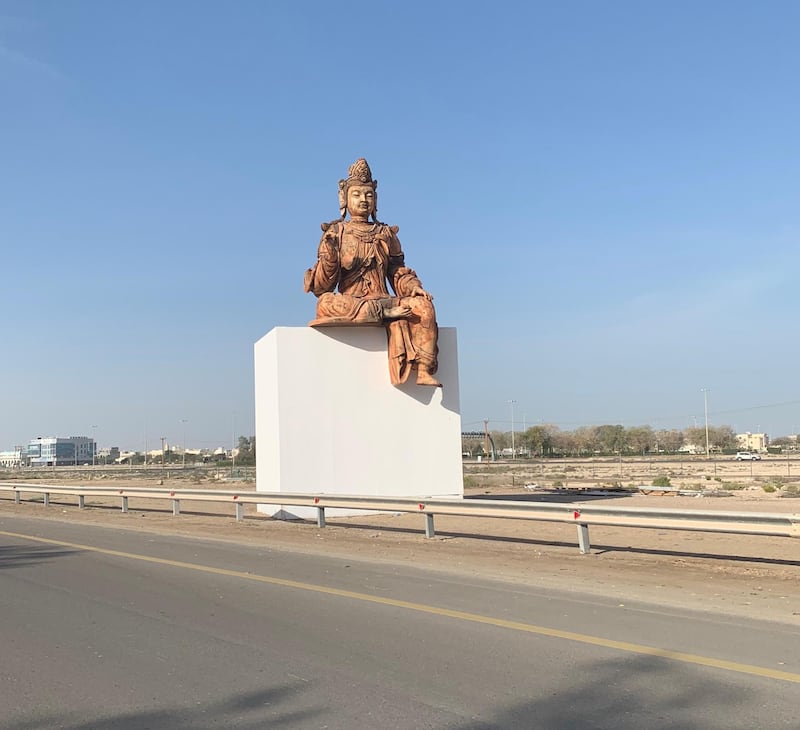Did you notice a Buddhist sculpture on the E11 Sheikh Zayed Road this morning? It's sitting proudly, with perfect posture and one leg folded, next to the arterial road near Al Rahba in Abu Dhabi as part of the second Highway Gallery by Louvre Abu Dhabi.
The gallery, which officially launches on Sunday April 7, is made up of ten artwork replicas: reproduced as giant 3D sculptures or as 10-metre-high billboards.
The Buddhist work is a reproduction of the wooden Guanyin, Bodhisattva of Compassion from China, which is dated from between 1050 and 1150. It is the work that greets visitors when they arrive at the Asian Trade Routes gallery in the Saadiyat Island museum.
Here's the ancient Chinese sculpture sitting proudly in Louvre Abu Dhabi:

Another 3D piece that will stand tall along the highway this month is a reproduction of a 4,000-year-old Bactarian Princess statuette from Central Asia (dated around 2,300 BCE):

Overall, the collection of 10 works will reflect many moments in history, as well as different peoples and cultures. There will be an image of a vase found on the UAE island of Marawah circa 5,500 BCE; a look at a 15th century Islamic helmet; a 17th century Hindu manuscript and, already installed, is a giant-sized replica of Japanese suit of armour from the early 18th century.
Representing the 19th century will be James Whistler's seminal 1871 portrait of his mother sitting, staring out at the distance. There's also Van Gogh's 1888 work The Dance Hall in Arles, which is known for its movement, frenetic energy and use of curves. Moving to the 20th century, you'll pass by a surrealist work by Joan Miro.
You can also learn more about the pieces on your drive: from next Sunday you will be able to tune into Radio 1 FM (100.5FM), Classic FM (91.6 FM) and Emarat FM (95.8 FM), and as you drive towards the display, you will automatically hear a 30-second story about each work. How? There's a trigger a few metres before each work that sets off the audio (ah, technology). The narrations will be read by well-known UAE personalities, including entrepreneur Anas Bukhash, figure skater Zahra Lari and chef Khaled Alsaadi.
Speaking of Highway Gallery 2.0, Mohamed Khalifa Al Mubarak, Chairman of the Department of Culture and Tourism, pointed out that the works chosen this year highlight Louvre Abu Dhabi's culturally open approach in this, the Year of Tolerance:
"The Highway Gallery is a prime example of our efforts to make art and culture an integral part of everyday life in the UAE, further enriching the lives of those who reside, work, and visit here. As the UAE celebrates the Year of Tolerance in 2019, we see the Highway Gallery as an extension of Louvre Abu Dhabi’s physical galleries, bringing its universal collection of works from different geographies and cultures, and its celebration of humanity, to the widest possible audience.”
Last year's Highway Gallery included major Louvre Abu Dhabi works and loans such as Piet Mondrian's Composition with Blue, Red, Yellow and Black (1922); the first work by Leonardo da Vinci shown in the Emirates, La Belle Ferronniere (1495-1499); and one of the oldest monumental statues still existing, a haunting sculpture of a two-headed figure from the Neolithic era (about 6500 BCE) that was found in Ain Ghazal, Jordan.
“This road is so important, linking the two main cities,” said Manuel Rabate, the director of Louvre Abu Dhabi, at the launch of last year's Highway Gallery. “We thought, what can we add with an interesting, creative process? Let’s bring the content to the people, if they can learn something, we can change a little bit the monotony of the drive.”






